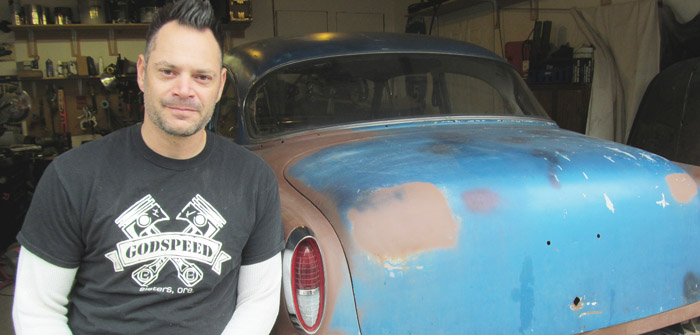(Photo above: Erik Himbert, who hopes to market his specialty wheelchair, built the prototype and has remodeled two cars in his home’s garage shop | Photo by Steve Kadel)
A Central Oregon man has won a nationwide contest by designing and building a wheelchair that allows users increased mobility as well as health benefits. Erik Himbert of Sisters hopes his award will be a springboard to producing and marketing the product.
The 38-year-old man was named grand prize winner this month by Eastwood Co., which makes vehicle restoration and customizing tools. The company’s DIY Challenge required contestants to build a transportation device entirely by themselves. A panel of judges made the final decision among five finalists, rating each entry on originality, creativity and online votes from the public.
“Erik’s build shows creativity in both design and execution,” judge Mike Joy wrote on the DIY Challenge website. “His build required as much or more special design and fabrication than the others. This is where a do-it-yourselfer stands out and achieves ‘legendary’ status.”
Himbert and friend Paul Rollins were guests of Eastwood for three days in Las Vegas this month, during which Himbert was announced as national winner. Himbert attended the Specialty Equipment Market Association’s (SEMA) trade show with his winning project on display and was a focus of attention from attendees. Being there also fulfilled a longtime goal.
“The SEMA show has always been on my bucket list,” he said. “It’s not open to the public. It’s really cool to see that stuff.”
When not appearing at the show, Himbert said, he and Rollins were treated like royalty by Eastwood officials.
“It was awesome,” he said. “They chauffeured us around.”
The choice to build a stand-up wheelchair was easy for Himbert, whose legs were paralyzed in a 2009 snowboarding accident. He was an active person before the injury, playing hockey three times a week in addition to pursuing mountain sports. Being confined to a wheelchair was a difficult change.
Instead of feeling sorry for himself, Himbert started brainstorming a way to regain as much movement as possible. First he designed and built a standing metal frame with which he could hoist himself from the chair for periods of time.
“The problem with that was I’m just standing, not going anywhere,” he said.
So Himbert went back to the drawing board and came up with the stand-up wheelchair, once again building it in the garage of his home. The new device allowed Himbert to retain some muscle tone rather than sitting all the time.
“Bone density is a big problem, too,” he said. “So is blood flow. Being confined to a chair, I see how bad it is on our bodies to be sitting for so long. When I got out of the hospital, it was all about how could I recover and do things I did before. You have no idea how frustrating it is to be 6-foot-3 and not be able to do simple things like change a lightbulb or reach things on the top shelf at the grocery store.”
Now Himbert hopes to give other wheelchair-users the same expanded freedom he enjoys. His goal is to partner with someone for financial backing of the venture. Those who are interested in a potential partnership may contact him at erikhimbert@gmail.com.
However, Himbert’s vision doesn’t necessarily lead to monetary wealth.
“I’m not in it for the money,” he said. “I want to help other people.”
Some companies already make standing wheelchairs, but Himbert considers those too heavy and expensive. Also, they don’t break down easily to put into a car as does his model, he said.
Himbert is a man of strong faith who teaches music at Sisters Christian Academy in addition to offering private music lessons. His range of abilities has always included aptitude for mechanics. Before building the stand-up wheelchair, he renovated a 1958 Chevrolet pickup truck and a 1954 Bel Air car in his garage, designing the hand controls for both vehicles.
“I think I’ve been an engineer since I was born,” he said. “I’ve always been interested in how things work. Not having the use of my legs has required me to build things to be able to do what I want in life.”
Himbert had been toying with the idea of building a standing wheelchair for quite a while before hearing about the Eastwood contest.
During the summer, when Himbert was named one of the five finalists, Eastwood flew him and Rollins to Philadelphia for announcement festivities. The company also gave each finalist $500 and equipment valued at up to $2,000 to help them complete their project.
Despite the contest having ended, Himbert continues to fine-tune his stand-up chair.
“It’s kind of a prototype and I’m still working out the bugs,” he said recently. “I did it over a six-week period, but I think most of it was scratching my head.”
The former Southern California resident acknowledged that his faith helped him handle effects of the snowboarding accident. The moment he was hurt remains vivid in his mind.
Himbert slammed into an ice block at high speed, thinking it was powder snow that would simply lift him off the ground a bit. Instead, he shot into the air and shattered a vertebra on the crash-landing. He spent more than two months in a hospital.
“It was bad,” he said. “It was like falling from a two-story building.”
Now, Himbert’s mountain sports life has ended but he has new motivation with the possible manufacture and distribution of stand-up wheelchairs.
“The contest kick-started this idea I had in my head,” he said. “The contest is good exposure, if nothing else. It’s not about myself. I’ve always thought, ‘How can I make this help other people?’”





